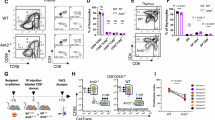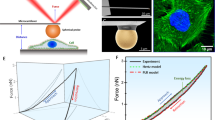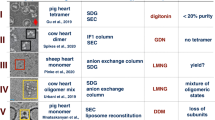Abstract
Adenine nucleotide translocases (ANTs) transport ADP and ATP through mitochondrial inner membrane, thus playing an essential role for energy metabolism of eukaryotic cells. Mice have three ANT paralogs, Ant1 (Slc25a4), Ant2 (Slc25a5) and Ant4 (Slc25a31), which are expressed in a tissue-dependent manner. While knockout mice have been characterized with Ant1 and Ant4 genes, which resulted in exercise intolerance and male infertility, respectively, the role of the ubiquitously expressed Ant2 gene in animal development has not been fully demonstrated. Here, we generated Ant2 hypomorphic mice by targeted disruption of the gene, in which Ant2 expression is largely depleted. The mice showed apparently normal embryonic development except pale phenotype along with a reduced birth rate. However, postnatal growth was severely retarded with macrocytic anemia, B lymphocytopenia, lactic acidosis and bloated stomach, and died within 4 weeks. Ant2 depletion caused anemia in a cell-autonomous manner by maturation arrest of erythroid precursors with increased reactive oxygen species and premature deaths. B-lymphocyte development was similarly affected by Ant2 depletion, and splenocytes showed a reduction in maximal respiration capacity and cellular ATP levels as well as an increase in cell death accompanying mitochondrial permeability transition pore opening. In contrast, myeloid, megakaryocyte and T-lymphocyte lineages remained apparently intact. Erythroid and B-cell development may be particularly vulnerable to Ant2 depletion-mediated mitochondrial dysfunction and oxidative stress.
Similar content being viewed by others
Log in or create a free account to read this content
Gain free access to this article, as well as selected content from this journal and more on nature.com
or
Abbreviations
- 7AAD:
-
7-aminoactinomycin D
- ANT:
-
adenine nucleotide translocase
- BM:
-
bone marrow
- CFU-E:
-
colony-forming unit-erythroid
- CFU-GM:
-
colony-forming unit-granulocyte macrophage
- CsA:
-
cyclosporin A
- ECAR:
-
extracellular acidification rate
- ES cell:
-
embryonic stem cell
- FCCP:
-
fluoro-carbonyl cyanide phenylhydrazone
- FL:
-
fetal liver
- GI:
-
gastrointestinal
- HCT:
-
hematocrit
- HGB:
-
hemoglobin
- HSV-TK:
-
herpes simplex virus thymidine kinase
- IRES:
-
internal ribosome entry site
- LSK:
-
lineage-negative Sca1 and c-Kit positive
- MCV:
-
mean corpuscular volume
- MNGIE:
-
mitochondrial neurogastrointestinal encephalopathy
- mPTP:
-
mitochondrial permeability transition pore
- mtDNA:
-
mitochondrial deoxyribonucleic acid
- OCR:
-
oxygen consumption rate
- PARP:
-
poly ADP ribose polymerase
- PB:
-
peripheral blood
- PI:
-
propidium iodide
- POLG:
-
polymerase γ
- RBC:
-
red blood cell
- RDW:
-
red blood cell distribution width
- ROS:
-
reactive oxygen species
- SIBN:
-
splicing acceptor-IRES-β-galactosidase-neomycin
- SOD:
-
superoxide dismutase
- TMRM:
-
tetramethyl rhodamine methyl ester
- TP:
-
thymidine phosphorylase
- TUNEL:
-
terminal deoxynuclotidyl transferase-mediated dUTP nick-end labeling
- WT:
-
wild type
References
Klingenberg M . Molecular aspects of the adenine nucleotide carrier from mitochondria. Arch Biochem Biophys 1989; 270: 1–14.
Nelson DR, Felix CM, Swanson JM . Highly conserved charge-pair networks in the mitochondrial carrier family. J Mol Biol 1998; 277: 285–308.
Fiore C, Trézéguet V, Le Saux A, Roux P, Schwimmer C, Dianoux AC et al. The mitochondrial ADP/ATP carrier: structural, physiological and pathological aspects. Biochimie 1998; 80: 137–150.
Duszyński J, Bogucka K, Letko G, Küster U, Kunz W, Wojtczak L . Relationship between the energy cost of ATP transport and ATP synthesis in mitochondria. Biochim Biophys Acta 1981; 637: 217–223.
Klingenberg M . The ADP and ATP transport in mitochondria and its carrier. Biochim Biophys Acta 2008; 1778: 1978–2021.
Doerner A, Pauschinger M, Badorff A, Noutsias M, Giessen S, Schulze K et al. Tissue-specific transcription pattern of the adenine nucleotide translocase isoforms in humans. FEBS Lett 1997; 414: 258–262.
Chinopoulos C, Vajda S, Csanády L, Mándi M, Mathe K, Adam-Vizi V . A novel kinetic assay of mitochondrial ATP-ADP exchange rate mediated by the ANT. Biophys J 2009; 96: 2490–2504.
Vyssokikh MY, Katz A, Rueck A, Wuensch C, Dörner A, Zorov DB et al. Adenine nucleotide translocator isoforms 1 and 2 are differently distributed in the mitochondrial inner membrane and have distinct affinities to cyclophilin D. Biochem J 2001; 358 (Part 2): 349–358.
Brand MD, Pakay JL, Ocloo A, Kokoszka J, Wallace DC, Brookes PS et al. The basal proton conductance of mitochondria depends on adenine nucleotide translocase content. Biochem J 2005; 392 (Part 2): 353–362.
Sharer JD, Shern JF, Van Valkenburgh H, Wallace DC, Kahn RA . ARL2 and BART enter mitochondria and bind the adenine nucleotide transporter. Mol Biol Cell 2002; 13: 71–83.
Zoratti M, Szabò I . The mitochondrial permeability transition. Biochim Biophys Acta 1995; 1241: 139–176.
Stepien G, Torroni A, Chung AB, Hodge JA, Wallace DC . Differential expression of adenine nucleotide translocator isoforms in mammalian tissues and during muscle cell differentiation. J Biol Chem 1992; 267: 14592–14597.
Levy SE, Chen YS, Graham BH, Wallace DC . Expression and sequence analysis of the mouse adenine nucleotide translocase 1 and 2 genes. Gene 2000; 254: 57–66.
Brower JV, Lim CH, Han C, Hankowski KE, Hamazaki T, Terada N . Differential CpG island methylation of murine adenine nucleotide translocase genes. Biochim Biophys Acta 2009; 1789: 198–203.
Rodic N, Oka M, Hamazaki T, Murawski MR, Jorgensen M, Maatouk DM et al. DNA methylation is required for silencing of ant4, an adenine nucleotide translocase selectively expressed in mouse embryonic stem cells and germ cells. Stem Cells 2005; 23: 1314–1323.
Brower JV, Rodic N, Seki T, Jorgensen M, Fliess N, Yachnis AT et al. Evolutionarily conserved mammalian adenine nucleotide translocase 4 is essential for spermatogenesis. J Biol Chem 2007; 282: 29658–29666.
Kehoe SM, Oka M, Hankowski KE, Reichert N, Garcia S, McCarrey JR et al. A conserved E2F6-binding element in murine meiosis-specific gene promoters. Biol Reprod 2008; 79: 921–930.
Chevrollier A, Loiseau D, Reynier P, Stepien G . Adenine nucleotide translocase 2 is a key mitochondrial protein in cancer metabolism. Biochim Biophys Acta 2011; 1807: 562–567.
Graham BH, Waymire KG, Cottrell B, Trounce IA, MacGregor GR, Wallace DC . A mouse model for mitochondrial myopathy and cardiomyopathy resulting from a deficiency in the heart/muscle isoform of the adenine nucleotide translocator. Nat Genet 1997; 16: 226–234.
Brower JV, Lim CH, Jorgensen M, Oh SP, Terada N . Adenine nucleotide translocase 4 deficiency leads to early meiotic arrest of murine male germ cells. Reproduction 2009; 138: 463–470.
Kokoszka JE, Waymire KG, Levy SE, Sligh JE, Cai J, Jones DP et al. The ADP/ATP translocator is not essential for the mitochondrial permeability transition pore. Nature 2004; 427: 461–465.
Hofker MH, Deursen Jv . Transgenic Mouse Methods and Protocols, 2nd edn. Humana Press: New York, NY, USA, 2011.
Esposito LA, Melov S, Panov A, Cottrell BA, Wallace DC . Mitochondrial disease in mouse results in increased oxidative stress. Proc Natl Acad Sci USA 1999; 96: 4820–4825.
Halestrap AP, Brenner C . The adenine nucleotide translocase: a central component of the mitochondrial permeability transition pore and key player in cell death. Curr Med Chem 2003; 10: 1507–1525.
Kim HS, Je JH, Son TG, Park HR, Ji ST, Pokharel YR et al. The hepatoprotective effects of adenine nucleotide translocator-2 against aging and oxidative stress. Free Radic Res 2012; 46: 21–29.
Ho L, Titus AS, Banerjee KK, George S, Lin W, Deota S et al. SIRT4 regulates ATP homeostasis and mediates a retrograde signaling via AMPK. Aging (Albany, NY) 2013; 5: 835–849.
Park JI, Kim SG, Baek MW, Park TJ, Lim IK, Seo YW et al. B-cell translocation gene 2: expression in the rat ovary and potential association with adenine nucleotide translocase 2 in mitochondria. Mol Cell Endocrinol 2013; 367: 31–40.
Wallace DC, Fan W . The pathophysiology of mitochondrial disease as modeled in the mouse. Genes Dev 2009; 23: 1714–1736.
Dogan SA, Trifunovic A . Modelling mitochondrial dysfunction in mice. Physiol Res 2011; 60: S61–S70.
Inoue S, Yokota M, Nakada K, Miyoshi H, Hayashi J . Pathogenic mitochondrial DNA-induced respiration defects in hematopoietic cells result in anemia by suppressing erythroid differentiation. FEBS Lett 2007; 581: 1910–1916.
Chen ML, Logan TD, Hochberg ML, Shelat SG, Yu X, Wilding GE et al. Erythroid dysplasia, megaloblastic anemia, and impaired lymphopoiesis arising from mitochondrial dysfunction. Blood 2009; 114: 4045–4053.
Kuma A, Hatano M, Matsui M, Yamamoto A, Nakaya H, Yoshimori T et al. The role of autophagy during the early neonatal starvation period. Nature 2004; 432: 1032–1036.
Pua HH, Dzhagalov I, Chuck M, Mizushima N, He YW . A critical role for the autophagy gene Atg5 in T cell survival and proliferation. J Exp Med 2007; 204: 25–31.
Miller BC, Zhao Z, Stephenson LM, Cadwell K, Pua HH, Lee HK et al. The autophagy gene ATG5 plays an essential role in B lymphocyte development. Autophagy 2008; 4: 309–314.
López LC, Akman HO, García-Cazorla A, Dorado B, Martí R, Nishino I et al. Unbalanced deoxynucleotide pools cause mitochondrial DNA instability in thymidine phosphorylase-deficient mice. Hum Mol Genet 2009; 18: 714–722.
Haraguchi M, Tsujimoto H, Fukushima M, Higuchi I, Kuribayashi H, Utsumi H et al. Targeted deletion of both thymidine phosphorylase and uridine phosphorylase and consequent disorders in mice. Mol Cell Biol 2002; 22: 5212–5221.
Hirano M, Silvestri G, Blake DM, Lombes A, Minetti C, Bonilla E et al. Mitochondrial neurogastrointestinal encephalomyopathy (MNGIE): clinical, biochemical, and genetic features of an autosomal recessive mitochondrial disorder. Neurology 1994; 44: 721–727.
Hirano M, Martí R, Spinazzola A, Nishino I, Nishigaki Y . Thymidine phosphorylase deficiency causes MNGIE: an autosomal recessive mitochondrial disorder. Nucleosides Nucleotides Nucleic Acids 2004; 23: 1217–1225.
Adams DJ, Quail MA, Cox T, van der Weyden L, Gorick BD, Su Q et al. A genome-wide, end-sequenced 129Sv BAC library resource for targeting vector construction. Genomics 2005; 86: 753–758.
Bai RK, Perng CL, Hsu CH, Wong LJ . Quantitative PCR analysis of mitochondrial DNA content in patients with mitochondrial disease. Ann NY Acad Sci 2004; 1011: 304–309.
Medeiros DM . Assessing mitochondria biogenesis. Methods 2008; 46: 288–294.
Cho JS, Kook SH, Robinson AR, Niedernhofer LJ, Lee BC . Cell autonomous and nonautonomous mechanisms drive hematopoietic stem/progenitor cell loss in the absence of DNA repair. Stem Cells 2013; 31: 511–525.
Cho J, Shen H, Yu H, Li H, Cheng T, Lee SB et al. Ewing sarcoma gene Ews regulates hematopoietic stem cell senescence. Blood 2011; 117: 1156–1166.
Gao J, Sana R, Calder V, Calonge M, Lee W, Wheeler LA et al. Mitochondrial permeability transition pore in inflammatory apoptosis of human conjunctival epithelial cells and T cells: effect of cyclosporin A. Invest Ophthalmol Vis Sci 2013; 54: 4717–4733.
Acknowledgements
We thank Dr. Laurence Morel (University of Florida) for providing antibodies for hematopoietic precursor sorting, Dr. Brian Harfe for the Flp vector, Drs. Clayton Matthews, William Dunn, Chen Liu and W Strat May for helpful discussion and technical advice and Dr. Katherine Santostefano for critical reading of the manuscript. We also appreciate Dr. Robert Anderson (Newcastle University, UK) for his advice on cardiac histology. This research was supported in part by National Institutes of Health Grants (HD060474 to NT; DK079879 and DK090115 to JK), and a research grant from Otsuka Maryland Medicinal Laboratories to NT.
Author Contributions
JC performed research, analyzed data, designed research and wrote the paper; JS, CHL, TS, M-HL, RRC performed research; YJL, HK, J-SK analyzed data; SPO analyzed data and designed research; YJL performed research, analyzed data and designed research; and NT designed research, analyzed data and wrote the paper.
Author information
Authors and Affiliations
Corresponding authors
Ethics declarations
Competing interests
The authors declare no conflict of interest.
Additional information
Edited by S Fulda
Supplementary Information accompanies this paper on Cell Death and Differentiation website
Supplementary information
Rights and permissions
About this article
Cite this article
Cho, J., Seo, J., Lim, C. et al. Mitochondrial ATP transporter Ant2 depletion impairs erythropoiesis and B lymphopoiesis. Cell Death Differ 22, 1437–1450 (2015). https://doi.org/10.1038/cdd.2014.230
Received:
Revised:
Accepted:
Published:
Issue date:
DOI: https://doi.org/10.1038/cdd.2014.230
This article is cited by
-
Osmoregulatory strategies of estuarine fish Scatophagus argus in response to environmental salinity changes
BMC Genomics (2022)
-
Determination of a six-gene prognostic model for cervical cancer based on WGCNA combined with LASSO and Cox-PH analysis
World Journal of Surgical Oncology (2021)
-
H+ transport is an integral function of the mitochondrial ADP/ATP carrier
Nature (2019)
-
Mitochondrial ATP transporter depletion protects mice against liver steatosis and insulin resistance
Nature Communications (2017)
-
Sensitivity of hematopoietic stem cells to mitochondrial dysfunction by SdhD gene deletion
Cell Death & Disease (2016)



